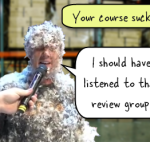Those who design elearning courses are the bridge between the client who has specific expectations and the learner who has to take the course. Ideally, the learner has expectations but sometimes they take the course because they have to and not because it’s what they want to do.
Building the bridge for performance-based courses is a little easier. Because the client has performance expectations, you’re better able to build the learning environment around performance. So they tend to be more relevant to the learners. Ultimately, the learner knows that the measure of success isn’t in the course, but instead in improved performance. So their motivation is a different.
It’s more challenging when you build information-based courses. I’ve found that the client is almost exclusively focused on the information rather than the learning. This is where the instructional design comes in. How do you create a learning process when most of it is focused on information?
The good thing is that motivated learners require less effort on your part. For example, I was doing a home improvement project and need to learn how to put up crown molding. I did a search online and found the information I needed. It was bland information with boring old text, no multimedia, and interactivity. However, I didn’t mind, because I was motivated to learn.
So the key to success is to influence the learner’s motivation. This works for performance or information-based courses. To do this, put yourself in the learner’s perspective and answer these three questions.

It’s important to develop learning objectives and then build the course content around meeting those objectives. This is good. However, what that usually translates into is a bullet point list of “You will learn this…” type of objectives.
While showing a list of objectives to your learner isn’t bad, what you really want to do is convince the learner that this course is valuable and will make a difference in what they do or know. When the learners understand that the course has value, their motivation increases. And motivation translates to a better learning experience.
So when you craft objectives for the course, it’s less about presenting a list and more about getting the learner to perceive value and understand how the course helps them. That’s why scenarios and case studies are so effective. They show the learner the course information in a relevant context. This helps them perceive its value.

No one likes to waste time on irrelevant elearning courses. When people commit their time to a course, they want to know why it’s important and then what they’re expected to do with this new information.
That’s why you build your information around what you expect the learner to do. Even compliance training is built on a foundation of performance expectations. You don’t prevent hearing loss because your employees know they need to wear ear plugs. Instead, you prevent it because your employees are actually wearing the ear plugs.

Everything centers on what actions you expect. When people know what the expectations are, they’re diligent to achieve them. Let’s go back to the argument in a previous post about why people just click through the course. The reason they click through is because they perceive that the content is not relevant. In that case, the only performance expectation they have is to complete the course. So they are diligent to demonstrate that they can complete the course. In a sense, because we haven’t answered the first two questions, our course design incents them to click through to completion. You can prevent this.
- Make the course relevant to the learner.
- Help the learner understand how they’ll use the information.
- Create a way for the learner to prove they understand it. The closer you can get to how they would apply the information in the real world, the better the learning experience.
Quiz questions are fine, but the reality is that we rarely have to make multiple choice decisions outside of elearning courses and the occasional Cosmopolitan survey. Ideally we design a way to measure the learners understanding that is more than selecting correct answers.
I read of a school that was teaching about nutrition. They could have given a quiz to measure understanding. Instead, they had the children design a week’s worth of menus for a summer camp. The menus had to be healthy and they had to explain their choices. As you can imagine, based on the menus designed, you’d get a better sense of the learner’s understanding than if you just had them select from a list of correct answers.

I’ve been in this industry long enough to know when and why we make the courses we do. The reality is that a lot of times the courses are pointless and don’t warrant a lot of extra effort. In fact, you might actually save the organization money by making them as simple as possible and letting people get back to work.
I also know that it’s a lot easier to make courses centered on the information rather than the learner. They require less effort and time. And to get around learner dropout (which can be anywhere from 25% to 50%), we’ll do things like lock the navigation and make courses compulsory.
However, if you really want to bring value to your courses and make them meaningful to your learners, answer these three questions:
- Why I am taking this course?
- What am I supposed to do with all of this information?
- How can I prove I know it?
How would you design your courses to answer these questions? Share your ideas by clicking the comments link.
Events
Free E-Learning Resources



















0
comments